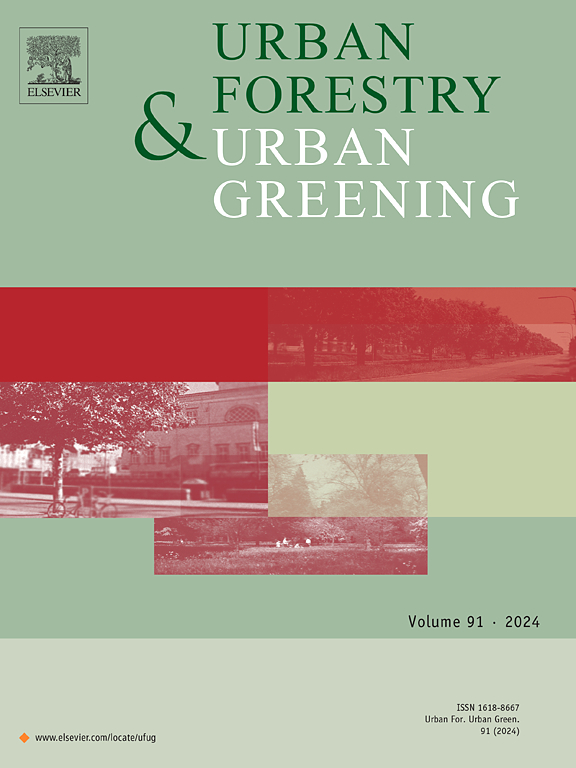Parks and Social Capital: An Analysis of the 100 Most Populous U.S. Cities
IF 6
2区 环境科学与生态学
Q1 ENVIRONMENTAL STUDIES
引用次数: 0
Abstract
In recent years, much attention has focused on strategies to reverse the decline of social capital in the United States. Increased social capital, which includes both intergroup contact and civic engagement, has many important benefits. For low-income individuals, friendships with high-income individuals (“economic connectedness”, a measure of inter-group contact) are one of the strongest predictors of their ability to escape poverty and gain increased life opportunities. Volunteering, a measure of civic engagement, is hypothesized to be key in building trust among neighbors. Urban parks are often thought to be a ‘third place’ that may increase social capital within a community through both increased ‘mixing and mingling’ and increased civic engagement. This study finds that residents of cities with better quality park systems (as measured by the ParkScore Index) are more socially connected and engaged with their neighbors (as measured by the Social Capital Atlas) than are residents of cities with lower-ranking park systems. Relative to the bottom 25 ranked cities, the top 25 ParkScore cities had 26% more social connections between different income groups, 61% more volunteers per capita, and 45% more civic organizations per capita. These patterns held after controlling for other factors such as education, race/ethnicity, poverty, and family structure. These ‘other’ factors often had stronger associations with the social capital indicators, suggesting park systems are an important, but not primary, driver of a community’s social capital. People living in cities with more parks and recreational opportunities may be more likely to realize these important benefits.公园与社会资本:对美国100个人口最多城市的分析
近年来,扭转美国社会资本下降趋势的策略备受关注。增加社会资本,包括群体间接触和公民参与,有许多重要的好处。对于低收入个人来说,与高收入个人的友谊(“经济联系”,一种衡量群体间联系的指标)是他们摆脱贫困和获得更多生活机会能力的最强预测因素之一。志愿服务是公民参与的一种衡量标准,被认为是在邻居之间建立信任的关键。城市公园通常被认为是“第三个地方”,可以通过增加“混合和混合”和增加公民参与来增加社区内的社会资本。该研究发现,公园系统质量较好的城市(以ParkScore指数衡量)的居民与邻居(以社会资本地图集衡量)的社会联系和参与度高于公园系统质量较低的城市的居民。与排名靠后的25个城市相比,ParkScore排名靠前的25个城市不同收入群体之间的社会联系多26%,人均志愿者多61%,人均民间组织多45%。在控制了教育、种族/民族、贫困和家庭结构等其他因素后,这些模式仍然成立。这些“其他”因素通常与社会资本指标有更强的关联,这表明公园系统是社区社会资本的重要驱动力,但不是主要驱动力。住在有更多公园和娱乐机会的城市里的人可能更有可能意识到这些重要的好处。
本文章由计算机程序翻译,如有差异,请以英文原文为准。
求助全文
约1分钟内获得全文
求助全文
来源期刊

Urban Forestry & Urban Greening
FORESTRY-
CiteScore
11.70
自引率
12.50%
发文量
289
审稿时长
70 days
期刊介绍:
Urban Forestry and Urban Greening is a refereed, international journal aimed at presenting high-quality research with urban and peri-urban woody and non-woody vegetation and its use, planning, design, establishment and management as its main topics. Urban Forestry and Urban Greening concentrates on all tree-dominated (as joint together in the urban forest) as well as other green resources in and around urban areas, such as woodlands, public and private urban parks and gardens, urban nature areas, street tree and square plantations, botanical gardens and cemeteries.
The journal welcomes basic and applied research papers, as well as review papers and short communications. Contributions should focus on one or more of the following aspects:
-Form and functions of urban forests and other vegetation, including aspects of urban ecology.
-Policy-making, planning and design related to urban forests and other vegetation.
-Selection and establishment of tree resources and other vegetation for urban environments.
-Management of urban forests and other vegetation.
Original contributions of a high academic standard are invited from a wide range of disciplines and fields, including forestry, biology, horticulture, arboriculture, landscape ecology, pathology, soil science, hydrology, landscape architecture, landscape planning, urban planning and design, economics, sociology, environmental psychology, public health, and education.
 求助内容:
求助内容: 应助结果提醒方式:
应助结果提醒方式:


